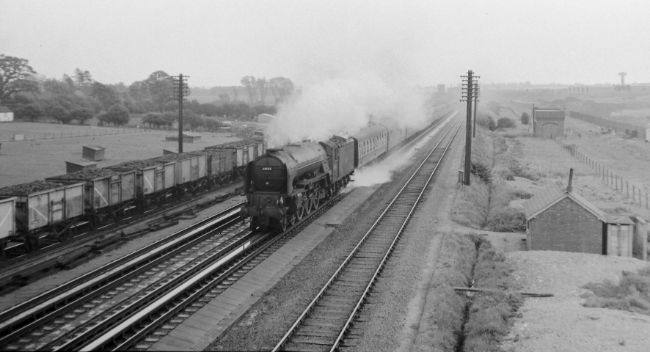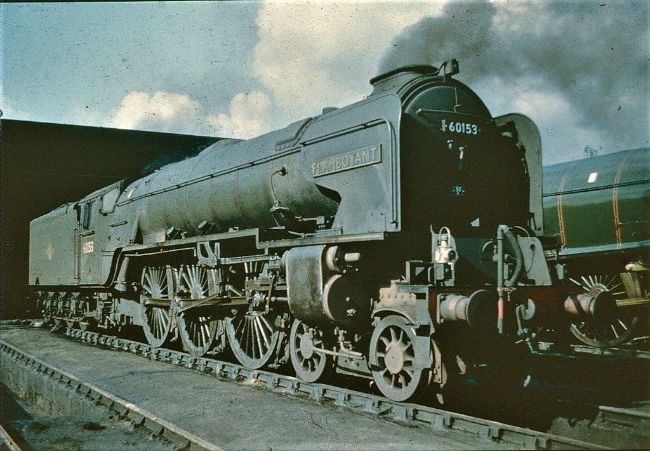And now for something completely slightly different! No. 60153 was the first of five Peppercorn Class A1s to be equipped with Timken roller bearings at the outset, a change to the original design that added some £18.500 to the cost of each locomotive so fitted. It was hoped that the mileage between heavy repairs could be increased as a result and this was proved in traffic, the roller bearing fitted locomotives averaging 118,000 miles between works visits compared to 100,000 miles for the rest of the class; indeed, with the exception of No. 60153, these engines had all exceeded 900,000 miles by 1962 when mileage records ceased to be kept. The reason for this particular locomotive’s lower mileage will become apparent in this potted history. No. 60153 emerged from Doncaster on 26th August 1949, Works No. 2047, carrying the new BR express passenger blue livery lined out in black and white with the trademark of ‘The Plant Works’, a tender festooned with dome-headed rivets. It was immediately allocated to York shed which was to remain its home shed for its entire life and began what was, for a Peppercorn A1, a remarkably uneventful career. For almost the first two years of its life its principle duty was handling the 12:15hrs Newcastle-York service, only being interrupted for ‘Light Casual’ repairs at Doncaster during February and April 1950 before returning there that June for a ‘Heavy Casual’ to repair damage sustained in an accident, No. 60153 was hauling an express passenger train which was derailed at Tollerton, North Yorkshire, due to heat buckling the track. The only consolation for this unfortunate occurrence was that No. 60153 left ‘The Plant’ bearing the name Flamboyant, another A1 to be named after a racehorse owned by Mrs. G. Robinson, this time a top-class stayer who won the Doncaster Cup in 1921 and the Goodwood Cup in 1922.
After returning to work another regular turn the locomotive handled was the 08:30hrs York-Newcastle parcels train, returning with the balancing 12:10hrs parcels service, these trains being mixed with 22.05hrs and 03:02hrs equivalent workings. Occasionally breaking this routine was the 13:38hrs Leeds-Newcastle train, No. 60153 being recorded on this service on 9th and 27th November and 8th January 1951. Following a couple of ‘Light Casual’ repairs during the year, Flamboyant was sent to Doncaster on 25th October for a general overhaul (it is not recorded if the boiler was changed) appearing back in traffic in BR passenger green livery, lined in black and orange and bearing the early emblem on the tender. At some stage during 1951 No. 60153 lost its plain chimney and gained the cast iron, lipped version. 1952 found Flamboyant spreading its wings by working more trains to London, being first recorded at King’s Cross on 28th May and then appearing again on the 09:15hrs York-King’s Cross on 3rd June but, despite receiving attention at Doncaster in July, failed hauling the same service on 28th November, being taken off the train at Newark. Following an unclassified repair at Doncaster from 17th to 24th December the locomotive took part in speed trials between Doncaster and Berwick on 21st April 1953, possibly associated with the development of A.T.C. after the previous year’s appalling crash at Harrow & Wealdstone.
York did not have any top-class passenger work and diagrams mainly covered turns to Newcastle and back via Darlington although its allocation of A1s did cover locomotive failures and some specials. Later York acquired a regular through turn to London in the morning with the locomotive concerned returning on a parcels train shortly after 19:00hrs, a duty on which No. 60153 became a frequent performer. Flamboyant visited Doncaster again in July for general repairs and was not recorded hauling anything significant until it was noted on the up ‘Flying Scotsman’ on 3rd February 1954, thereafter being confined to hauling trains in the North East, mainly to Newcastle, many of which had originated in Colchester. On 14th April 1955, the locomotive was sent to Doncaster for a ‘General’ which included the fitting of a Diagram 117 boiler, No. 29787, which was significant in that it appeared back in traffic wearing a small dome cover, not the usual banjo type; although the Thompson boilers did not have the Gresley pattern perforated steam-collectors that Peppercorn re-introduced, the A1s tended to be fitted with their banjo covers over the smaller dome, albeit further forward that on the Diagram 118 boilers. It seems that Flamboyant was the only Peppercorn A1 to carry this rather plain cover, certainly not a flamboyant accessory! No. 60153’s diet of work throughout the rest of 1955 and ’56 continued to be somewhat humdrum, mainly consisting of taking Colchester trains forward to Newcastle although it was spotted on the down ‘Heart of Midlothian’ on 30th November.

Flamboyant at Langley Troughs on the 15:40hrs ex-King’s Cross, May 1961 – Peter Townend
1957 saw the locomotive appear more frequently at King’s Cross again although the early part of the year was interrupted by a general overhaul at Doncaster which included a boiler change, the Diagram 117 boiler being exchanged for a Diagram 118 version, No. 29800, and Flamboyant regaining the dignity of a banjo dome again. No. 60153 had one good turn at the end of the year, hauling the up ‘Flying Scotsman’ into King’s Cross on 21st December. Alas the locomotive was entering the somewhat premature twilight of its career, resuming its short haul duties in the North East for the next couple of years, visiting Doncaster for a ‘Light Casual’ in November 1958 and returning there for a general overhaul and its final boiler, No. 9669, on 1st March 1960, returning to traffic on 8th April. By the time it was withdrawn from York (North) shed (50A) on 2nd November 1962 Flamboyant had the dubious honour of being the A1 with the lowest recorded mileage, a mere 699,122 miles, a ridiculous waste of a useful asset but a direct result of its allocation to York. The locomotive had only carried four boilers during its career which was one of the shortest for an A1, just thirteen years, two months and seven days. Flamboyant was sent to Doncaster for scrapping on 28th March 1963, at a time when British Railways still had the capacity to dismantle its own locomotives before the final tide of withdrawals overwhelmed the organisation and the use of private contractors became the norm.

Flamboyant at Top Shed in later life – Richard Greenwood
This history was compiled by Graham Langer based on a database compiled by Tommy Knox, with reference to the RCTS book ‘Locomotives of the LNER Part 2A’ and ‘Yeadon’s Register of LNER Locomotives’ as background.